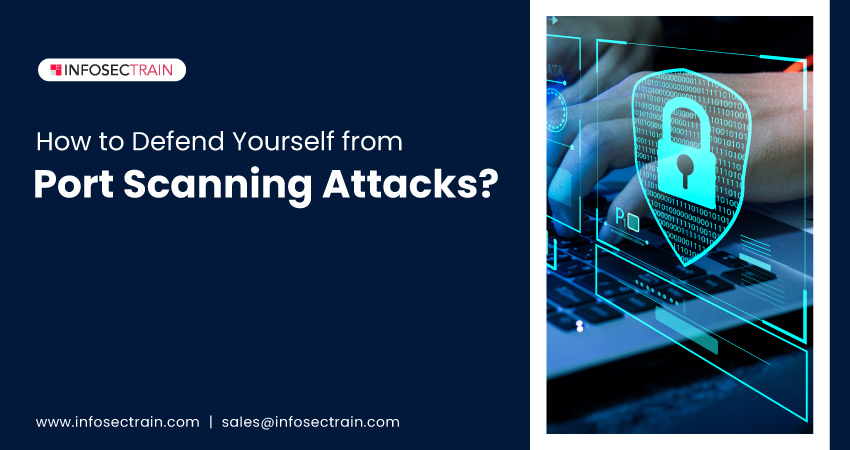How to Defend Yourself from Port Scanning Attacks?
In today’s interconnected world, the increasing reliance on the internet and networked systems has made cybersecurity an essential concern for individuals and organizations alike. Port scanning attacks are particularly concerning among the numerous cyber threats that pose risks to network security. Port scanning is a reconnaissance technique malicious actors use to discover open ports on a target system, potentially leading to unauthorized access and exploitation of vulnerabilities.

Defending against port scanning attacks is paramount for preserving the integrity and confidentiality of sensitive information. This article delves into effective strategies and countermeasures that individuals and organizations can employ to protect themselves from port scanning attacks.
Table of Contents
What is Port Scan?
Port Scanning Techniques
How to Protect Yourself Against Port Scanning Attacks?
What is Port Scan?
Port scans can initially appear harmless, yet they provide a mirror into your computer’s vulnerabilities. A port scan is an attacker’s method to identify open doors or vulnerable places in a network. Malicious hackers can use a port scan attack to identify open ports and determine whether they accept or reject data. Additionally, it can show whether an organization manages firewalls or other active security measures.
Port Scanning Techniques
To secure the network against port scan attacks, you must first understand the various types of port scans technique used by hackers.
1. Ping Scan : Ping scans scan a whole network block or a single target to determine whether a target is still alive. It attempts to reach the destination by sending an ICMP echo request; if the target responds with an ICMP reply, the attempt is successful. However, firewalls and routers are becoming more frequent to block ICMP pings, so you will probably need to turn to alternative techniques to determine whether the target is alive reliably.
2. Vanilla Scan : A vanilla scan is another simple port scanning technique that attempts to connect to all 65,536 ports simultaneously. It transmits either a synchronize (SYN) flag or a connection request. When it gets an SYN-ACK response, it answers with an ACK flag.
3. TCP Half-Open Scan : It is the most prevalent kind of port scan. This is a fast scan that can scan thousands of ports per second. It operates this way because the TCP handshake is not completed, and the connection is not completed; it simply sends a packet with the SYN flag set and awaits the target’s SYN-ACK.
4. Stealthy Scan (Null, Fin, X-MAS) : These are known as stealth scans because the packet flags are built to try to elicit a response from the target without actually going through the handshaking process and establishing a connection with them.
- A packet that would never be sent in the real world is sent during the FIN scan, and it sends a packet with the FIN flag set without connecting to the destination.
- Additionally, NULL scans send a packet that has no place in the real world. The TCP packet is delivered at the target without having any variables put on it.
- The X-MAS tree scan got its name because it “lights up the packet like a Christmas tree.” It creates a TCP packet with the URG, PUSH, and FIN flags and sends it to the destination.
5. UDP Scan : UDP (User Datagram Protocol) scans are the most often used technique for preventing DNS, SNMP, and DHCP services. UDP scans operate by transmitting a typically empty packet. Each port can be adjusted or set to a random payload. The port is closed if the target answers with an ICMP unreachable error (code 3, type 3) packet. The packet is filtered if it replies with an ICMP unavailable error message with additional codes.
6. TCP (Transmission Control Protocol) Connect Scan : This is similar to the half-open scan, except it completes the handshake process and establishes a connection by transmitting the last Ack message. This is a considerably slower port scanning method because it requires more packets to complete.
7. FTP (File Transfer Protocol) Bounce Scan : This method allows the sender to hide their location by bouncing packets through an FTP server.
How to Protect Yourself Against Port Scanning Attacks?
Port scanning is a common tool cyber attackers use to identify vulnerable websites. They frequently use it to establish enterprises’ security levels, determine whether businesses have good firewalls, and find insecure networks or servers. Some TCP approaches allow attackers to conceal their position as well.
Your network system will be open to port scans if you have a publicly accessible server. But you can take various steps to reduce your vulnerabilities.
1. Install a Firewall
A firewall is a type of hardware and software that prevents unauthorized network access, and it examines data flow using a set of rules to detect and prevent threats. A firewall can protect a company’s private network against illegal access. It manages ports and their availability and identifies when a port scan is happening before terminating it.
2. TCP Wrappers
TCP wrappers provide access control and authentication for network services on Linux servers, allowing or limiting access based on IP and web addresses. Acting as a protective filter, TCP Wrapper monitors incoming packets and verifies the authorization of external systems trying to connect. If authorized, access is granted; otherwise, access is denied. This essential feature ensures network security by permitting or preventing connections to “wrapped” services, enhancing the overall protection and control of the server’s accessibility.
3. Discovering Network Holes
Organizations can use a port checker or scanner to see if more ports are open than necessary. They must do regular system audits to identify any weak points or weaknesses that an attacker could exploit.
A network’s vulnerabilities to malicious hacking can be tested via port scanning, which counts open ports and evaluates how well the network’s security mechanisms perform to prevent unauthorized access. Various strategies are crucial because cybersecurity experts must use the proper port scanning techniques depending on the network environment and the most recent cyberattacks.
How can InfosecTrain Help?
InfosecTrain is one of the leading training organizations. It provides valuable assistance in defending against port scanning attacks through its specialized cybersecurity training courses. Our CEHv12 training course equips participants with essential skills to defend against port scanning attacks and other cybersecurity threats. The course covers advanced techniques for detecting and mitigating port scanning activities, fortifying network defenses, and safeguarding sensitive data. By enrolling in InfosecTrain’s CEHv12 training, individuals and organizations can enhance their cybersecurity posture and effectively protect against potential port scanning attacks.
TRAINING CALENDAR of Upcoming Batches For CEH v13
| Start Date | End Date | Start - End Time | Batch Type | Training Mode | Batch Status | |
|---|---|---|---|---|---|---|
| 26-Jul-2025 | 31-Aug-2025 | 19:00 - 23:00 IST | Weekend | Online | [ Open ] | |
| 16-Aug-2025 | 28-Sep-2025 | 19:00 - 23:00 IST | Weekend | Online | [ Open ] |







 1800-843-7890 (India)
1800-843-7890 (India)